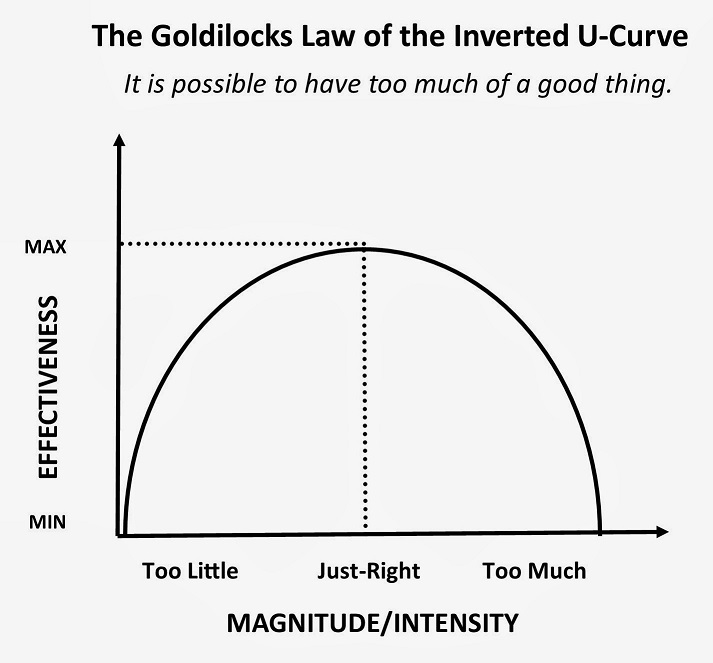Can mindfulness be too much of a good thing? As in recent years, we have seen a proliferation of mindfulness products and teachers, in what was called “the mindful movement”. In this blog post we explore the question, can mindfulness be too much of a good thing? The too-much-of-a-good-thing effect is when the practice of something positive reaches such levels where it becomes addictive or reaches an inflection point at which its effects either stabilize or turn negative.

An interesting article by Grant and Schwartz (2011) looks at the too-much-of-a-good-thing effect and they argue that traits that we might consider positive. Such as optimism, courage and curiosity might be non-monotonic. Therefore, following an inverted U-shaped curve. This means that positive things might have an optimal level. Where when such an optimal level is reached, beneficial effects might mitigate or even turn undesirable. Grant and Schwartz continue and argue that mindfulness might have non-monotonic effects. Given the popularity of mindfulness and the possibility of non-monotonic effects.
Should we investigate if there is an “optimal level of mindfulness” after which its effects can turn negative?
A recent study published in current opinion in psychology by Willoughby Britton (2019) looks for such effects within, “a number of different mindfulness-related processes (MRP), namely: mindful attention (mind-body awareness, interoception), mindfulness qualities, mindful emotion regulation (prefrontal control, decentering, exposure, acceptance), and mindfulness meditation practice” (Britton, 2019, p. 159). Likewise, can mindfulness be too much of a good thing? And if so, what’s the way forward? Following are Willoughby Britton’s findings:
Mindful attention
Mindful attention has been associated with a multitude of positive outcomes. Britton argues that the intentional redirection of one’s attention to present moment experience (a central tenant of mindfulness practice) can result in psychopathy because of high levels of self-focus. In fact, high levels of self-focus have been associated with poorer mental health outcomes especially in at-risk populations (Ingram, 1990; Mor & Winquist, 2002). Although Britton points out that paring such attention with qualities such as non-judgment/reactivity can act as a buffer against such negative outcomes.
What is noteworthy, is that Increases in mindful attention can also result in increased insular activation (Fox, et al., 2014; Gotink, et al., 2016). This has been associated with increases in well-being “especially” for persons who suffer from chronic pain (de Jong, et al., 2016). Although Britton (2019) argues that, “this does not mean that higher levels of interoception or insula activation beyond deficit reversal will continue to confer increasing benefit” (p. 160). Why, because increased insular activation has been observed to cause increased emotional intensity which if not managed well during mindfulness meditation can worsen depressive feelings, anxiety, PTSD in general and increases in pain intensity (Lindahl, et al., 2017; Lomas, et al., 2015)
Mindfulness qualities
Mindful qualities such as nonjudgment, curiosity, open-mindedness, acceptance, kindness, generosity and gratitude are foundational attitudinal qualities for the practice of mindfulness (Kabat-Zinn, 1996). What’s interesting is that research by Grant and Schwartz (2011) indicates that in certain situations and when taken to far, such qualities can result in negative outcomes.
Mindful emotion regulation
Mindful training has been associated with increased activation of the prefrontal cortex in relation to the limbic system and the amygdala. This increased activation can exert a damping effect on the latter with possible benefits towards emotional regulation (Tang, et al., 2015). Although such damping can result in emotional blunting and there have been documented cases of complete loss of positive and negative emotions and dissociation. These effects have been also observed in mindfulness meditation training (Lindahl, et al., 2017; Lomas, et al., 2015). Likewise, decentering as a result of mindfulness meditation has been found to act as the mediator for the reported increases in mindful emotional regulation and psychological wellbeing (van der Velden, et al., 2015).
However, mindfulness meditation increases the activity of the inferior parietal lobe. What is interesting is that switching from 1st to 3rd person perspective through mindfulness training has been hypothesized to activate the inferior parietal lobe dissociative pathways (Farb, et al., 2007). Britton makes the argument that given this overlap how can we be sure that there isn’t an optimal level of psychological distancing cultivated through mindfulness training. As Britton puts it, that ‘steps back’ far enough but not too far?” (p. 160).
Mindfulness meditation practice
In a review of mindfulness practice outcomes, Parsons et al. (2017) found that in 75% of the studies they assessed did not find any significant benefit as practice amount increased. On the contrary. They noticed that some of those studies indicated that as practice amount increased so did the possibility of negative outcomes. To illustrate this Britton uses the example that a meditation practice of less than 30 min a day actually improved sleep. But as practice amount increased beyond this it causes increased cortical arousal which had a detrimental effect on sleep outcomes (Ferrarelli, et al., 2013).
Where does this leave us
As with any other psychological process, mindfulness-related processes can be beneficial. Still, under certain situations, conditions or at certain levels. Mindfulness related processes can have negative or undesirable effects. For example, the mindfulness related process of acceptance or reappraisal can be of benefit or detriment according to the situation. Putting it simply accepting a situation when there are no other alternatives can ease distress. While failure of reappraising certain situations and not taking the necessary corrective measures can lead to psychological distress (Troy, et al., 2013). With Britton commenting that, “the utility and benefit of any psychological process is dependent on the interaction between person and context” (p. 161).
Therefore, if there is the possibility that mindfulness follows the too much of a good thing type effect. It is important that we look at the mediating factors that could result in negative effects, even when one follows a correct practice. This reminds me of the goodness to fit model. Where it does not mean that because we observe beneficial outcomes from some kind of practice it can fit the whole population. There are always outliers and it is important to note those outliers and adapt our meditation teaching practice according to the context and situations related to the individual’s circumstances.
Why?
Because if meditation and our aim as meditation teachers is to ease suffering. What is the use of our practice? If we take a rigid stance and do not take a person-centred approach in our teaching practice by adapting our knowledge to the individual’s needs. Isn’t that why we argue and are thought to focus on a compassionate ethic within our own personal practice?
What are your thoughts comment below?
In the next post we will be looking at some mediating factors for mindfulness-related processes subscribe to our mailing list to receive a notification.


This shows us that mindfulness is quite a powerful tool!
true
“This reminds me of the goodness to fit model. Where it does not mean that because we observe beneficial outcomes from some kind of practice it can fit the whole population.”
90% of our community (population) is inherently lazy. Meditation will never appeal or can never be applied to the “whole population” because of the laziness issue.
you might have a point that people might take a step back from starting a practice of meditation because of how they experience life. Although I would be cautious with labels such as lazy. We are called to practice compassion.
I think being rigid and expecting all our answers to come from one source or practice is too much. I used to be guilty of this from hereditary programming. We are here to experience and when we expand our outer world, our inner world expands too. Great article to make one explore additional sources not just alternative ones.